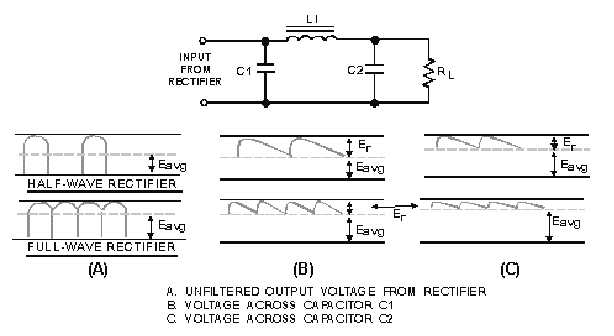3-33
LC Capacitor-Input Filter
The LC input filter is one of the most commonly used filters. This type of filter is used primarily in
radio receivers, small audio amplifier power supplies, and in any type of power supply where the output
current is low and the load current is relatively constant.
Figure 3-38 shows an LC capacitor-input filter and its associated waveforms. Both half-wave and
full-wave rectifier circuits are used to provide the inputs.
Figure 3-38.—LC capacitor-input filter and waveforms.
The waveforms shown in the figure represent the unfiltered output from a typical rectifier circuit.
Note again, that the average value of output voltage (Eavg) for the half-wave rectifier is less than half the
amplitude of the voltage peaks. This is indicated by the dashed line. The average value of output voltage
(Eavg) for the full-wave rectifier is greater than half, but is still much less than the peak amplitude of the
rectifier-output waveform. With no filter circuit connected across the output of the rectifier circuit
(unfiltered), the waveform has a large value of pulsating component (ripple) as compared to the average
(or dc) component.
A common type of LC filter is shown in figure 3-38. C1 performs the same functions as discussed
earlier by reducing the ripple to a relatively low level. L1 and C2 form the LC filter, which reduces the
ripple even further (view C).
L1 is a large value iron-core inductor (choke.) It has a high value of inductance and, therefore, a high
value of XL, which offers a high reactance to the ripple frequency. At the same time, C2 offers a very low
reactance to the ac ripple. L1 and C2 form an ac voltage divider and, because the reactance of LI is much
higher than that of C2, most of the ripple voltage is dropped across L1. Only a slight trace of the ripple
appears across C2 and the load.
While the L1-C2 network greatly reduces the ac ripple, it has little effect on the dc. You should
recall that an inductor offers no reactance to dc. The only opposition to current flow is the resistance of

